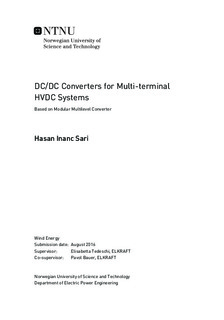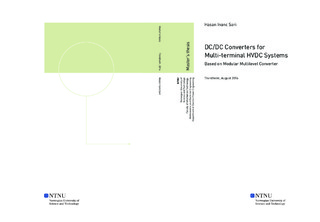| dc.description.abstract | The increase in the energy demand has resulted in searching for new energy sources. Due to the increased prices of fossil fuels and the environmental issues, renewable energy sources has become popular in Europe. Renewable energy generation such as wind, solar and wave has point-to-point connections with the main grid. In order to minimize the disadvantages of renewable energy sources like energy fluctuations, multi-terminal systems are favoured interconnecting energy generation stations among them with the main grid.
The long distance interconnection especially for offshore wind farms and intercontinental connections is not possible with traditional alternating current (AC) technology because of the limited power transfer. Therefore, high voltage direct current (HVDC) technology is considered as the main element for the future multi-terminal grid. The conversion between AC and DC is preferred via voltage source converters (VSC) as they offer more flexible power control compared to traditional current source converters in other words line commutated converters (LCC).
HVDC power transmission schemes have been constructed depending on the technology of the time, which means that there is no standardization in voltage levels and configurations of the HVDC schemes. Therefore, the connection of such systems operating at different voltage levels and/or in different schemes such as monopole and bipolar systems for the future multi-terminal DC grids requires DC/DC converters. Although the voltage level and the configurations are the same for both DC systems, DC/DC converter may be required for the power flow control in multi-terminal DC grid. The modular multilevel converter (MMC) seems as the most suitable converter in this application due to its advantages such as low switching losses, high scalability and modularity.
MMC control structures are introduced and front-to-front connection of two MMC forming a DC/AC/DC converter is modelled and simulated for different applications such as interconnecting systems with same voltage levels, different voltage levels or different configurations in this study. The passive element sizes of MMC submodules are also compared for different AC side frequency as the component sizes can be decreased thanks to the increase in the AC frequency which has a disadvantage of higher switching losses. Moreover, the designed converters are tested in multi-terminal DC grids to check their performance and functionality. | |

